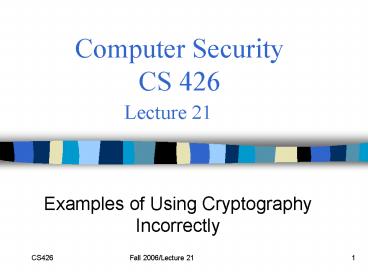Computer Security CS 426 Lecture 21 - PowerPoint PPT Presentation
1 / 14
Title:
Computer Security CS 426 Lecture 21
Description:
Allow recount, provide confidence in results. Who might attack system? Voter wants ... Diebold Election Systems. Unfortunately, linear congruential generators ... – PowerPoint PPT presentation
Number of Views:65
Avg rating:3.0/5.0
Title: Computer Security CS 426 Lecture 21
1
Computer Security CS 426Lecture 21
- Examples of Using Cryptography Incorrectly
2
Related Readings
- Analysis of an electronic voting system
- Kohno, Stubblefield, Rubin, Wallach, 2004
- Intercepting Mobile Communications The
Insecurity of 802.11 - Borisov, Goldberg, Wagner, 2001
- The Final Nail in WEPs Coffin
- Bittau, Handley, Lackey, 2006
3
Example voting machine
- Standard hardware
- Commercial OS
- Many run WinCE
- Programmable
- Specify election
- Smartcard authentication
- Invalidate card when done
- Data output
- Network, or
- Place disk in another computer
4
Basic security analysis
- What is voting system supposed to do?
- Correctly count votes
- One person, one vote
- Voter privacy
- Prohibit vote selling
- Allow recount, provide confidence in results
- Who might attack system?
- Voter wants to vote twice
- Election worker
- Programmer working for voting machine company
5
Diebold Case Study
T. Kohno, A. Stubblefield, A. Rubin, D. Wallach
- Proprietary system
- Certification mandated by election laws
- Without public review Security through obscurity
- Diebold system leaked
- AccuVote-TS DRE system, Oct 2000 - April 2002
- Available on open ftp server
- Identified by activist Bev Harris
- Some zip files, cvs repository
- DMCA concern over zip encryption
- Available on New Zealand site
6
Some problems
- Encrypted votes and audit logs
- define DESKEY ((des_key)"F2654hD4")
- No authentication of smartcard to voting terminal
- Insufficient code review
7
Sample comment in code
- // LCG - Linear Conguential Generator
- // used to generate ballot serial numbers
- // A psuedo-random-sequence generator
- // (per Applied Cryptography,
- // by Bruce Schneier, Wiley, 1996)
Unfortunately, linear congruential generators
cannot be used for cryptography Page
369 Applied Cryptography, by Bruce Schneier
- BallotResults.cpp Diebold Election Systems
8
Other problems
- Smartcards use no cryptography
- Votes kept in sequential order
- Several glaring errors in cryptography
- Inadequate security engineering practices
- Default Security PINs of 1111 on administrator
cards - Windows Operating System
- tens of millions of lines of code
- new critical security bugs announced frequently
9
802.11 Security
- Used between a Wireless Access Point and Wireless
Ethernet Cards - Existing security consists of two subsystems
- A data encapsulation technique called Wired
Equivalent Privacy (WEP) - An authentication algorithm called Shared Key
Authentication - Goals
- Create the privacy achieved by a wired network
- Simulate physical access control by denying
access to unauthenticated stations
10
WEP Encapsulation
- WEP Encapsulation Summary
- A master key shared between the end points
- Encryption Algorithm RC4
- Per-packet encryption key 24-bit IV
concatenated to a master key - WEP allows IV to be reused with any frame
- Data integrity provided by CRC-32 of the
plaintext data (the ICV) - Data and ICV are encrypted under the per-packet
encryption key
11
What Went Wrong in WEP?
- The space of IV is too small IV is sent in
clear. - With two messages encrypted using the same IV,
one can recover the key stream. - The attack is made much easier by chosen
plaintext attacks, which can be carried out in
the environment where WEP is used.
12
Ways to Accelerate the Attack
- Send spam into the network no pattern
recognition required! - Get the victim to send e-mail to you
- The AP creates the plaintext for you!
- Decrypt packets from one Station to another via
an Access Point - If you know the plaintext on one leg of the
journey, you can recover the key stream
immediately on the other - Etc., etc., etc.
13
Fragmentation Attacks
- Knowing several bytes of plaintexts in the
beginning of a message enables one to extract the
beginning of key streams - Using fragmentation, one can send messages using
a short key stream - By crafting messages sent to a particular IP
address, one can have the WAP decrypt to get the
plaintext and long key stream - Attack can be carried out after receiving one
packet
14
Coming Attractions
- November 9
- Introduction to network security































